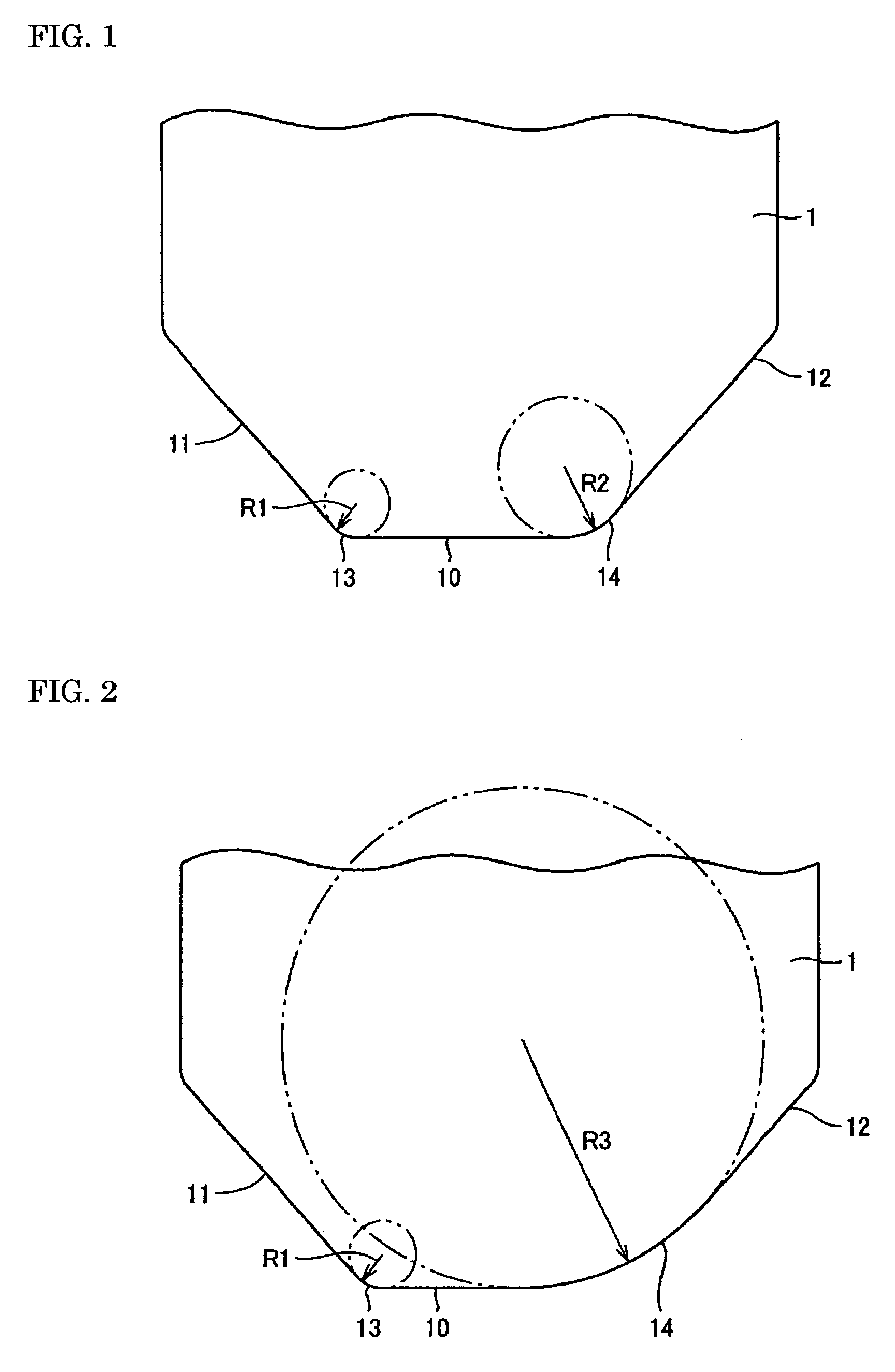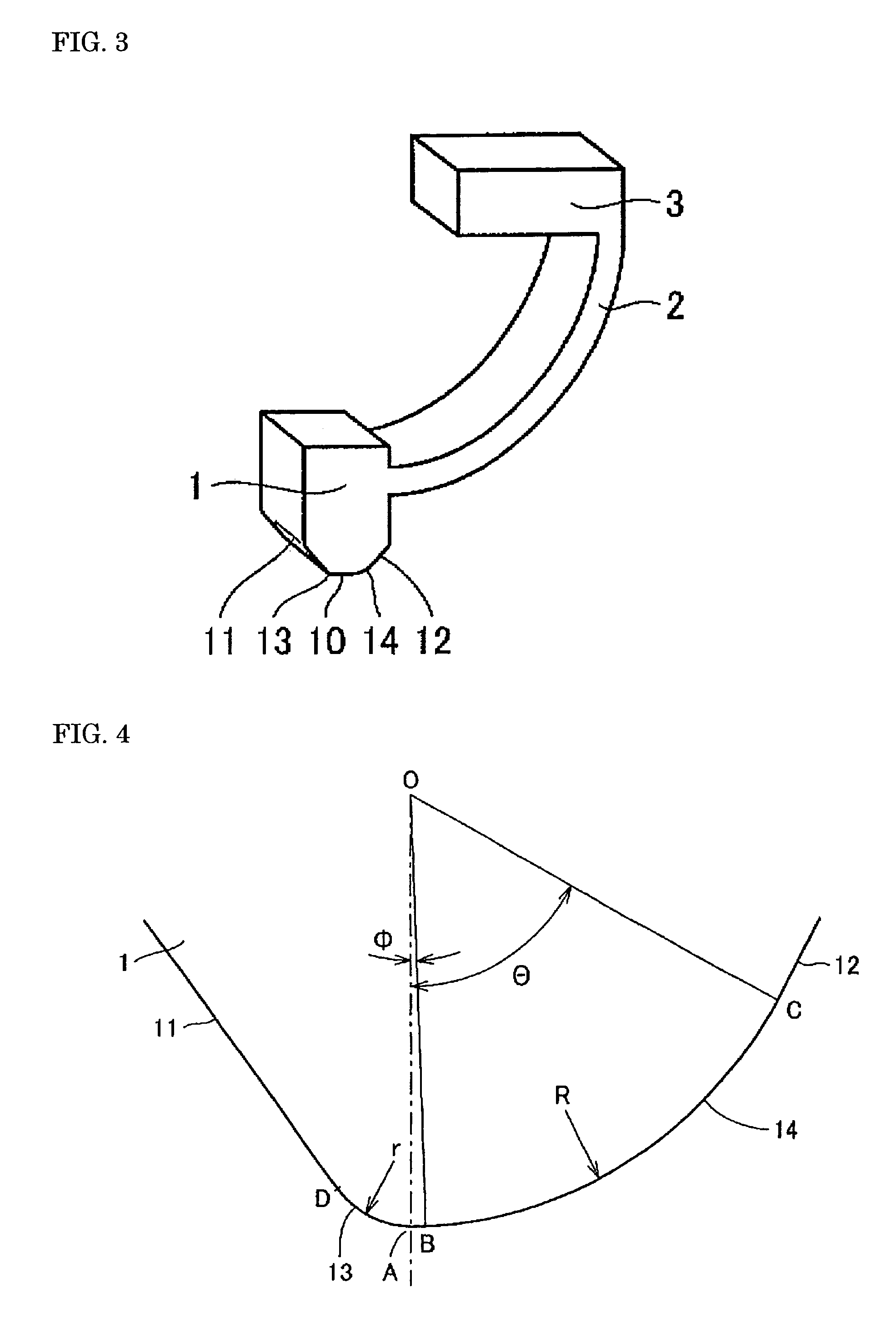Contact probe
- Summary
- Abstract
- Description
- Claims
- Application Information
AI Technical Summary
Benefits of technology
Problems solved by technology
Method used
Image
Examples
embodiment 1
(Structure)
[0094]A contact probe in Embodiment 1 according to the present invention is explained below by referring to FIG. 1. FIG. 1 is an enlarged view of the tip portion 1. In the contact probe, a first oblique face 11 refers to an oblique face that moves in the lead when the tip portion 1 moves for performing the scrubbing by the force pressing the contact probe against the subject surface. As shown in FIG. 1, the first oblique face 11 is located at the left hand side of the contacting flat face 10. The opposite oblique face is referred to as a second oblique face 12. A corner portion 13 through which one end of the contacting flat face 10 is connected to the first oblique face 11 has a radius of curvature different from that of a corner portion 14 through which the other end of the contacting flat face 10 is connected to the second oblique face 12. As can be seen from FIG. 1, the corner portion 14 has the radius of curvature R2 larger than the radius of curvature R1 of the corn...
embodiment 2
(Structure)
[0099]A contact probe in Embodiment 2 according to the present invention is explained below by referring to FIG. 4. FIG. 4 is an enlarged view of the tip portion 1. During the scrubbing by pressing the contact probe against the subject surface, the tip portion 1 moves to the left in FIG. 4. Hereinafter, the side that moves in the lead in this direction is referred to as “the first side,” and the opposite side (right hand side in FIG. 4) is referred to as “the second side.” Therefore, the second side represents the side that moves in the lead during the scrubbing at the time of the dissociation of the contact probe from the subject surface.
[0100]As shown in FIG. 4, the tip portion 1 of the contact probe has no contacting flat face 10 described in Embodiment 1 (see FIGS. 1 and 2). The tip portion 1 has a corner portion 13 (from point B to point D) as a first corner portion at the first side and a corner portion 14 (from point B to point C) as a second corner portion at the ...
embodiment 3
(Structure)
[0106]A contact probe in Embodiment 3 according to the present invention is explained below by referring to FIG. 5. FIG. 5 is an enlarged view of the tip portion 1. As with the contact probe explained in Embodiment 2, this contact probe has the lowermost point A, a connecting point B, a corner portion 13 as a first corner portion, a corner portion 14 as a second corner portion, a first oblique face 11, a second oblique face 12, and point O as the center of the curvature of the corner portion 14. However, unlike the contact probe in Embodiment 2, the contact probe in Embodiment 3 has a suppressing portion between the corner portion 13 and the first oblique face 11. The suppressing portion is provided to suppress to the subject surface a bulging portion produced from the subject surface by the corner portion 13. The suppressing portion extends from the corner portion 13 toward the first side and includes a suppressing face 41 (from point E to point F) that is opposed to the...
PUM
 Login to View More
Login to View More Abstract
Description
Claims
Application Information
 Login to View More
Login to View More - R&D
- Intellectual Property
- Life Sciences
- Materials
- Tech Scout
- Unparalleled Data Quality
- Higher Quality Content
- 60% Fewer Hallucinations
Browse by: Latest US Patents, China's latest patents, Technical Efficacy Thesaurus, Application Domain, Technology Topic, Popular Technical Reports.
© 2025 PatSnap. All rights reserved.Legal|Privacy policy|Modern Slavery Act Transparency Statement|Sitemap|About US| Contact US: help@patsnap.com



